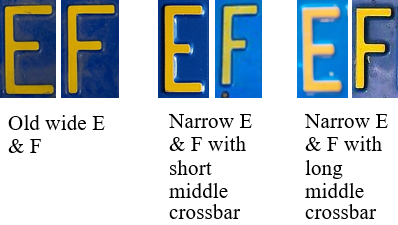
License plates issued during this era had raised yellow text on a blue background. "CALIFORNIA" was in smaller raised yellow text at the top, in characters that looked like block printing. At first, the letters were wider than the numeric digits, leaving enough room for a total of 6 characters plus one half-space.
There may have been some overlap between the beginning of this era in January 1969, and the end of the black license plate era, while the old stock of black plates was used up.
At the beginning of this era, some of these plates were made of steel and others were made of aluminum. You can tell whether a given plate is steel or aluminum by holding a magnet up to it. The steel plates are also subject to rusting. Later, all plates were made out of aluminum, a practice which continues to this day. According to California DMV records, 1972 was the last year steel license plates were made, bun one source claims to have steel plates issued in 1975.
It was in the middle of this era (1976) that California began issuing month stickers. These stickers were initially red-on-white, but were changed to blue-on-white in 1986.
By the middle of the 1970s, the number of vehicles registered in Califonia had become so enormous that it was clear the available 6-character license number combinations would soon run out. California had, and still has, a strict policy of never re-issuing the same license number to a different vehicle unless the original vehicle's owner pays for a "plate transfer." Even if the original vehicle had been sent to the junkyard years ago, its license number would never be reused. So when the combinations ran out in 1979, California became the first U.S. state to issue license plates with enough room for 7 characters plus one half-space. They accomplished this by narrowing the letters, but keeping the numeric digits the same width.
An easy way to tell the difference between a wide X and a narrow X is to compare the top and bottom of the letter. Wide X's are wider at the bottom than they are at the top; narrow X's are the same width on the top and the bottom.
When the letters were first narrowed, the middle crossbar on the E and F was short and stubby. These were changed to a long middle crossbar (almost, but not quite, as long as the top horizontal line on the letter) some time later.

As with black plates, the letter I on early blue plates was still just a simple vertical line with no serifs. The serifs on the 1 did distinguish it from the letter I, but there was still a risk of confusing the two. As a result, some time in the 1970s — after the switchover to 7-character plates — serifs were added to the top and bottom of the letter I.
Standard plates issued for passenger cars during the early-to-mid part of this era had license numbers that consisted of 3 numeric digits, followed by a half-space, followed by 3 letters. This was the reverse of the combination used on the older black plates. The first such plate issued would have been 000 AAA. The digits were incremented first, then when they wrapped back around to zeroes the letters were incremented, i.e. the plates would've gone 000 AAA, 001 AAA, 002 AAA, ..., 999 AAA, then 000 AAB, 001 AAB, etc..
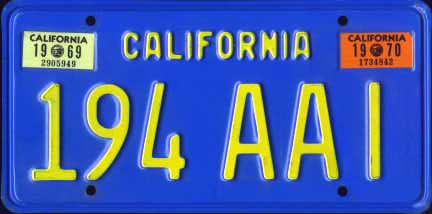
Image from
http://www.15q.net/ca.html
Due to the potential for confusion between the letter I and the number 1, and between the letters O and Q and the number 0, the 3-letter portion of the license number couldn't begin with an I, O, or Q. (Unlike the modern era, such license numbers could end with an I, O, or Q, however.)
Late in the 1970s, these combinations ran out. (By that time, the letters had already gotten narrower, allowing a smooth transition to 7-character license numbers.) From that point onward, the standard plates issued for passenger cars had license numbers consisting of the numeric digit 1, followed by 3 letters, followed by 3 numeric digits. No half-space was used between any of these characters, even though sufficient room for a half-space did exist on the plate. The first such plate issued would have been 1AAA000. As with the earlier combination, the digits were incremented first, then when they wrapped back around to zeroes the letters were incremented, i.e. the plates would've gone 1AAA000, 1AAA001, 1AAA002, ..., 1AAA999, then 1AAB000, 1AAB001, etc..
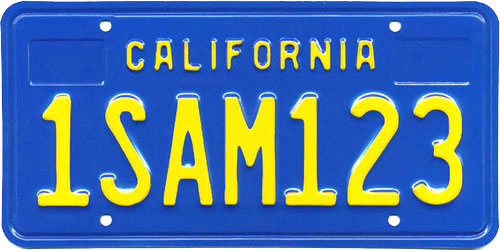
Image from
https://japanesenostalgiccar.com/true-history-of-period-correct-california-license-plates/
The 3-letter portion of these 7-character license plate numbers could neither begin, nor end, with an I, O, or Q.
In the early part of this era, standard plates issued for commercial vehicles continued the pattern in force at the end of the black plate era. That is, license numbers consisted of 2 numeric digits, followed by a half-space, followed by 3 numeric digits, followed by another half-space, followed by a letter. The digits were incremented first, going right-to-left, and when they wrapped around the letter was incremented, i.e. in the middle of the run the plates would've gone 00 000 M, 00 001 M, 00 002 M, ..., 99 999 M, then 00 000 N, 00 001 N, etc..
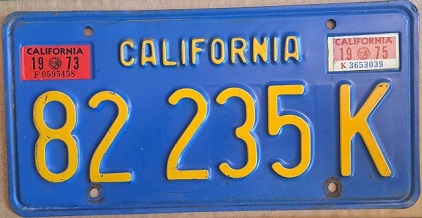
By the mid-1970s, these combinations ran out. In fact, they ran out before the 6-character passenger plate combinations ran out, probably due to the popularity of pickup trucks. This moment probably coincided with the narrowing of the letters on blue plates. From that point onward, license numbers for commercial vehicles consisted of a single numeric digit, followed by a single letter, followed by 5 numeric digits, with no half-spaces between any of these characters. The 5-digit group was incremented first, then when it wrapped around to zero the letter was incremented, then when the letter wrapped back around to A the first digit was incremented, i.e. the plates would've gone 1A00000, 1A00001, 1A00002, ..., 1A99999, 1B00000, 1B00001, ..., 1Z99998, 1Z99999, 2A00000, 2A00001, etc..
Standard plates issued for trailers during this era had license numbers that continued the pattern that had been in force throughout the black plate era. That is, two letters, followed by a half-space, followed by 4 numeric digits.
According to online sources, license numbers starting with UA through YX were issued to commercial weight fee trailiers. These were trailers bigger than a certain threshold, which are required to pay a weight fee as part of their registration cost. This practice is no longer followed, and instead the weight fee is now charged to the towing vehicle based on the combined weight with the trailer attached.
The transition from wide letters to narrow letters happened some time along the way.
Commercial vehicles can pay rather hefty registration fees. When a commercial vehicle is operated both in California and in one or more other states, it can opt to divide its registration fees among the states it operates in, in proportion to how much time or travelling distance it spends in each state. Such vehicles are issued an apportioned license plate by their "home" state. California began issuing these in 1982, during the blue license plate era, and continued the practice into the white plate eras. Of note is the fact that only one sticker well is present in the apportioned plates of this era; where the well for the month sticker would normally appear (in the upper left), these plates just have the word CAL in block lettering.
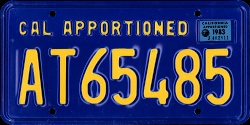

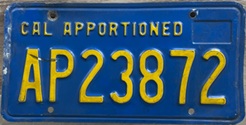
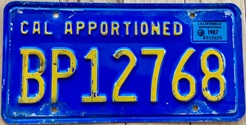
License numbers for these plates consist of 2 letters followed by 5 digits. Not all two-letter combinations are used.
Apportioned trailer license plate numbers made it into the CT's before the end of the blue plate era. Apportioned power unit license plate numbers, on the other hand, only made it a little of the way into the BP's.
During the blue license plate era, exempt plates continued to be indicated by an "E" on the left side of the plate inside an octagon or a diamond — octagon for local governments, diamond for the state government.
The license numbers for these plates consisted entirely of six numeric digits, continuing the pattern from the black license plate era.

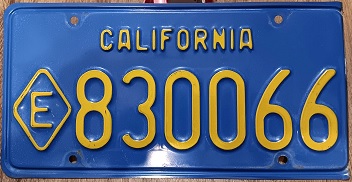
Send comments about this webpage to: rogermw@ix.netcom.com.
Go back to my main license plate index page.
Go back to Roger M. Wilcox's homepage.